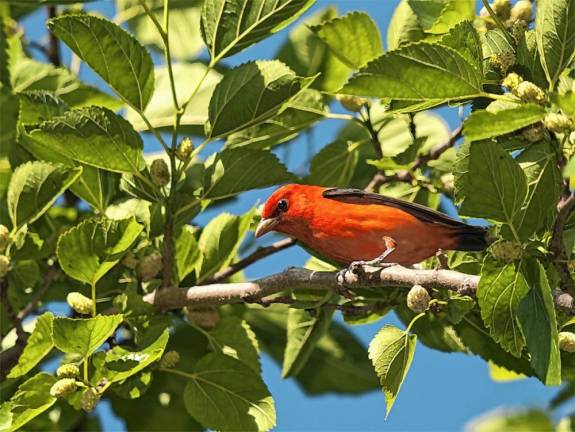
“A journey of a thousand miles begins with a single step,” according to a Chinese proverb.
In the avian world, journeys can last well over 1,000 miles - and begin with a flap rather than a step!
Each spring, birds known as “neotropical migrants” make incredible long-distance journeys to breed and raise young. These “New World” migrating birds spend winters in Central and South America and the Caribbean, with some as far away as the tip of South America.
As the days grow longer and warmer in North America, instincts developed over millennia tell these birds to head north to breed. They’re just now arriving in, and passing through, New Jersey!
What’s the advantage to migrating so far?
The arrival of spring in North America means plenty of emerging insects and places to nest. Because of the longer days and seasonal abundance of food, long-distance migrants can raise larger clutches of young than their tropical relatives who stay put.
How do birds know where they’re going?
Many species follow coasts or natural features, such as rivers and mountain ranges. Most birds that migrate to or through New Jersey follow the Atlantic Flyway, an avian superhighway that includes all of North America’s Atlantic coastline.
Birds also navigate by using the position of the sun and stars, sensing the earth’s magnetic field, and noticing landmarks during the day.
Bird migrations can be arduous, taking a couple of months for the species that travel the farthest. One long-distance migrant with a strong New Jersey connection is the red knot, a shorebird in the sandpiper family.
Red knots fly from the tip of South America to the Canadian arctic and are known for making a critical stopover along the Delaware Bay in New Jersey to fatten up on horseshoe crab eggs, which give them the energy to complete their journey.
Migrating birds can encounter many dangers on their travels, including predators; storms that make flying difficult and blow them off course; and a shortage of places to rest and refuel. Tall buildings with reflective windows are another major hazard, as are power lines.
Once neotropical migrants reach their northern destinations, they need to find suitable habitat for nesting. This can be a challenge in the many places where the landscape has been fragmented by development.
Fortunately, New Jersey has many great locations where birds can either pause along their migration routes or stay for the summer to nest and raise young.
According to the state Department of Environmental Protection (DEP), New Jersey has 361 species of neotropical migrating birds, including warblers and shorebirds. More than 130 species nest in New Jersey, and nearly 80 of those are songbirds whose melodious calls fill the air in spring.
Indeed, birdsong is a large part of what makes spring such a lovely and special season in New Jersey. Our neotropical migrants are singing their hearts out to attract mates ... and in doing so are winning our hearts!
Among the most beautiful songbirds are the wood warblers, a group of 36 species that includes yellow, black-and-white, cerulean, northern parula, prairie, pine and Cape May warblers. These colorful little birds, though challenging to spot in leafy forests, can often be identified by their songs.
Another group of neotropical migrants are the brightly-colored tanagers and orioles, including the scarlet tanager and Baltimore oriole. Then there’s eastern North America’s smallest bird, the ruby-throated hummingbird, which winters in Central America and breeds throughout the eastern United States and southeastern Canada.
If you live in a wooded area, you may have neotropical migrating birds in your backyard! But if you’re in a more urban location, don’t worry - there are plenty of places where you can see and hear them!
Among New Jersey’s many birding hotspots are Cape May Point State Park, the Sandy Hook unit of Gateway National Recreation Area, the Great Swamp National Wildlife Refuge, Sourland Mountain Preserve, Stokes State Forest and High Point State Park.
One urban gem that’s easily accessible to millions of New Jerseyans is Liberty State Park in Jersey City; the park’s Caven Point section is especially good for birdwatching.
At a recent bird hike at Liberty State Park, group members identified 73 bird species! Caven Point is located in the heart of New Jersey’s most densely populated region and deserves to be designated a “State Natural Area,” as Cape May has been. That would take it off the table forever as a potential site to expand the exclusive golf course next door!
If you’re new to birding, a great way to gain knowledge is by joining a guided hike. To find bird walks, check the websites of the New Jersey Audubon Society and other conservation groups.
Birding clubs are also a good bet, including those that help minorities and people of color get started. Check out the In Color Birding Club (incolorbirding.org), Black Outside (blackoutside.org),Amplify the Future (amplifythefuture.org), Latino Outdoors (latinooutdoors.org), BirdAbility (birdability.org) and Feminist Bird Club of Jersey City (feministbirdclub.org).
If you decide to try birding on your own, be sure to bring a pair of binoculars and consider downloading the Merlin bird ID app to your smartphone. Another great resource is the eBird portal (ebird.org/region/US-NJ), where birders report the species they’ve spotted.
Enjoy the amazing sights and sounds of neotropical migrants this spring!
For information about protecting New Jersey’s land and natural resources, including great birding spots, visit the New Jersey Conservation Foundation website at njconservation.org
Jay Watson is co-executive director of the New Jersey Conservation Foundation. He may be contacted at info@njconservation.org